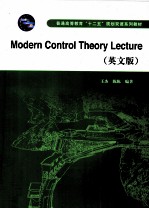
- 作 者:王杰,陈陈编著
- 出 版 社:北京:中国水利水电出版社
- 出版年份:2011
- ISBN:9787508484211
- 标注页数:201 页
- PDF页数:209 页
请阅读订购服务说明与试读!
订购服务说明
1、本站所有的书默认都是PDF格式,该格式图书只能阅读和打印,不能再次编辑。
2、除分上下册或者多册的情况下,一般PDF页数一定要大于标注页数才建议下单购买。【本资源209 ≥201页】
图书下载及付费说明
1、所有的电子图书为PDF格式,支持电脑、手机、平板等各类电子设备阅读;可以任意拷贝文件到不同的阅读设备里进行阅读。
2、电子图书在提交订单后一般半小时内处理完成,最晚48小时内处理完成。(非工作日购买会延迟)
3、所有的电子图书都是原书直接扫描方式制作而成。
Introduction 1
0.1 Development of control theory 1
0.2 Structural requirements and control features of the system 5
0.3 Nonlinear control in power system 10
0.4 The main content of modern control theory 17
Chapter 1 State-space expression of control system 18
1.1 The basic concepts 18
1.2 The simulation structure diagram of state-space expression 20
1.3 The construction of state-space expression 20
1.4 The construction of state-space expression from transfer function 25
1.5 Transfer function and transfer function matrix from transfer function to state equation 30
1.6 State-space expression of composite system 31
1.7 Linear transformation 34
1.8 State-space expression of discrete system 36
Exercise 39
Chapter 2 The solution of state-space expression of control system 43
2.1 Solution of homogeneous state equation of linear time-invariant system 43
2.2 Matrix exponent 43
2.3 Homogeneous solution of time-varying system 46
2.4 State transfer matrix 61
2.5 Solution of linear continuous system non-homogeneous state equation 62
2.6 Solution of discrete-time system state equation 63
2.7 Discretization of continuous time-state-space expression 64
Exercise 65
Chapter 3 Controllability and observability of linear system 69
3.1 Controllability of time-invariant discrete system 69
3.2 Controllability of time-invariable continuous system 71
3.3 Observability of time-invariant system 75
3.4 Controllability and observability of linear time-varying system 78
3.5 The dual relation of controllability and observability 85
3.6 Structural decomposition of linear time-invariant system 86
3.7 Relation of controllability,observability and transfer function matrix 89
3.8 Controllabi lity standard and observability standard 91
3.9 System realization 93
Exercise 96
Chapter 4 Stability and Lyapunov method 100
4.1 The basic concept of stability 100
4.2 The basic idea of Lyapunov function 104
4.3 Lyapunov function stability method 108
4.4 Asymptotic stability 111
4.5 Some common construction method of Lyapunov function 118
4.6 Vector Lyapunov function 128
4.7 Application of Lyapunov methods in linear system 130
4.8 Lyapunov method in Hamilton system 133
Exercise 142
Chapter 5 Synthesis of linear time-invariant system 145
5.1 Definition and property of state feedback 145
5.2 Pole assignment 146
5.3 System stabilization problem 150
5.4 System deeoupling problem 151
5.5 State observer 158
Exercise 169
Chapter 6 Optimal control 172
6.1 Summary 172
6.2 Variational methods of solving optimal control 173
6.3 Hamilton function 178
6.4 Phorcha problem 179
6.5 Minimum principle 181
6.6 Dynamic programming 189
6.7 Linear quadratic optimal control problem 196
Exercise 198
